
We were looking forward to our Tanzania trip, but 24 hours before we were due to fly we got an email to say the M.D. of our safari company had died, the admin was in chaos and all safaris were being cancelled and we could possibly rebook at a later date. What!? I went through a series of emotions, ranging from upset to stress to panic via a lot of cursing. I rang Bridgette and she said try and find a new company so we don’t lose our travel bookings. Anyway to cut a long story short I found Mark Pearson at Zambezi Safaris via Safari Bookings and he got us sorted in very quick time, so we were back underway.
Life ticks in CAPITALS in the report.
Thursday 5th September 2019
After an overnight flight of seven hours from Gatwick with Qatar Airways we landed in Doha, Qatar in fierce heat. We only had two hours before our transfer flight to Kilimanjaro so there was no time for airport birding but I did see three Laughing Doves, two House Sparrows and a Collared Dove.
We took off on time for the six hour flight down to Tanzania. We had obtained our visas from the Tanzanian Embassy before we went so we missed most of the scrum at the airport. It was with a little relief that our guide, Devis Kitumbo, was waiting for us with a cheery smile. As we walked to the Land Cruiser, our travelling home for the next six days, a Rock Martin flew over. Whilst Devis sorted the parking ticket we watched two tame Pied Crows taking a drink beside the vehicle. I had my first lifer before we left the airport, a stunning SUPERB STARLING was by the exit.


We were heading towards Arusha for the first night where we would be staying at The Arusha Hotel in the shadow of Mount Meru. Devis filled us in on our itinerary and pointed out interesting things along the route. This was bustling, colourful Africa at its best with traffic everywhere, brightly coloured buses tussled with tuk-tuks, goats, sheep, cattle and people were everywhere going about their business in roadside markets.

It took about an hour to reach our destination and Devis installed us in our hotel and said he would pick us up after breakfast. Along the route I added Black-headed Heron, Ring-necked Dove, Red-winged Starling, Magpie Shrike, Common Bulbul (pic), Speckled Mousebird (pic), Western Cattle Egret, Sacred Ibis and an AUGUR BUZZARD the first lifer of the trip, although only flight views, but we would get better views later in the holiday.

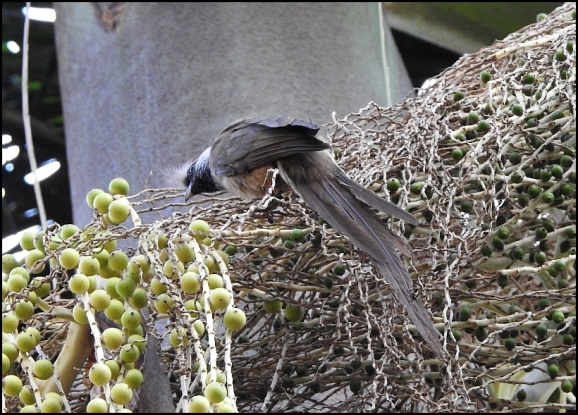
After dumping our bags in our room we headed out into the hotel’s garden to have a cup of tea and see if there were any new birds around. We saw Bronze Mannikins, Little Swifts, African Palm Swifts, a Yellow-billed Kite and 11 Hadeda Ibises flying to roost and a pale green Sunbird went unidentified. Our pot of tea cost 1000 Tanzanian shillings, to which Bridgette remarked we’d better check how much that is, it sounds a lot. We needn’t have panicked, it was 35p.
We dined on Kuku Mchica, a traditional chicken dish cooked with African spinach and coconut rice, it was very tasty. Then we fell into bed exhausted from 24+ hours non-stop travelling.
Friday 6th September 2019

After breakfast we got a very useful briefing from Adam, the safari rep, who told us what to expect, gave us phone numbers if we needed anything, including the Flying Doctor! He also advised us on the sticky issue of tipping. It was all very useful and professional. When he had finished Devis picked us up and we left Arusha driving for a couple of hours to Tarangire N.P. There was plenty to see on the way with regular herds of animals being walked to waterholes by Maasai tribesmen.

Six species were added along the route including two lifers – Barn Swallows in Arusha, Capped Wheatear at Duka Bovu, and a male VON DER DECKEN’S HORNBILL, House Sparrows, six YELLOW-COLLARED LOVEBIRDS and a Crowned Lapwing at Makuyuni. Lifers pictured below.


We arrived at Tarangire N.P. gate marked by a massive Baobab tree beside the entrance.

Devis sorted the permits and we used the restrooms and birded the car park whilst we waited. Then we entered the park stopping almost immediately for a plethora of new trip birds including seven lifers – Emerald-spotted Wood Doves, ASHY STARLINGS, Arrow-marked Babbler, Helmeted Guineafowl, WHITE-HEADED BUFFALO WEAVER, NORTHERN WHITE-CROWNED SHRIKE, African White-backed Vultures, Fork-tailed Drongo, Red-billed Buffalo Weavers, BLUE-CAPPED CORDONBLEU, STRIPED KINGFISHER, Red-cheeked Cordon-bleu, Green-winged Pytilia, HILDEBRANDT’S STARLING, Laughing Doves, SPECKLE-FRONTED WEAVERS and an Ashy Flycatcher. Lifers in the slideshow below in listed order (except Cordonbleu).
We arrived at a large waterhole, which was fantastic, the sort you see on wildlife documentaries, alive with mammals and birds. There were Waterbucks, Impalas, many Burchell’s Zebras and EASTERN WHITE-BEARDED WILDEBEESTS, a subspecies tick and very different to the Blue Wildebeests we had seen before. Birds included Common Ostriches, Blacksmith Plovers, Namaqua Doves (pic), two Bateleurs, Black-headed Herons, a pair of GREY-CROWNED CRANES, Water Thick-knees and African Palm Swifts.




We moved on to a second slightly smaller waterhole but it was just as busy. New trip mammals here included Warthogs, Elephants, Giraffes, Eland and Vervet Monkeys. Many more new trip birds were here with both lifers and more familiar species and included Lilac-breasted Roller, Grey Hornbill, African Grey Woodpecker, Wood Sandpiper, African Pied Wagtails, Red-billed Oxpeckers, Egyptian Geese, a GREY-HEADED KINGFISHER, RUFOUS-TAILED WEAVERS and African Jacana. There were also two Nile Monitors.




We drove on and saw both Dwarf and Banded Mongoose parties and our first Tawny Eagle of the trip. We pushed on to a spot where we could eat our picnic lunches. There were very good toilets here and we found this to be the case throughout all of the game reserves. We sat at picnic tables inside a steel cage, where the door could be shut to keep out monkeys or give protection if Lions turned up. There was nothing so exciting here though but various starlings, sparrows and weavers hunted below the tables to look for dropped food. You weren’t allowed to feed them.
After lunch we picked up two new life birds and a mammal as we were leaving, 5+ SWAHILI SPARROWS and a female SPEKE’S WEAVER were in spiky undergrowth (so no pics) and a cute KIRK’S DIK-DIK, a tiny antelope.

More new trip birds were added quickly in this area, two Green Wood-Hoopoes, a pair of Red-billed Firefinches and a Rüppell’s Vulture (pic) and at a small pond Intermediate Egret and a Hamerkop. Next we saw four GRANT’S GAZELLES, a male and three females, a really nice lifer to get, even though we would see many over the coming days.


Even more lifers followed during the course of the afternoon, a pair of NUBIAN WOODPECKERS, a DOUBLE-BANDED COURSER, two YELLOW-THROATED SANDGROUSE and a RED-NECKED SPURFOWL, the first three pictured below, also good views of another male Von der Decken’s Hornbill.



The day was about to get much better when Devis asked if we wanted to try for Cheetahs. Of course we said yes expecting to see fairly distant animals, however unbelievably a mother and cub were lying under a thorn bush no more than 10 feet from the road.


Even better no-one else was there so we had the best views of our lives, just us three and the two Cheetahs completely at ease with us, a magic moment!
Then Devis said I’ve got some Lions for you too, they were less than a mile away, and again we had incredible views. A battered old male with a lived-in face and a smart lioness with him. They were relaxing in the sun but eventually the lioness got up and we spent a long time watching her stalking Zebras, but we had to leave before the hunt’s conclusion which probably wouldn’t happen for a long while.


We saw a BARE-FACED GO-AWAY BIRD here and a YELLOW-NECKED SPURFOWL and a pair of WHITE-BELLIED BUSTARDS on the drive out of the park.


We made our way to Manyara Wildlife Safari Camp where we would be overnighting in a hut/tent combo. We were swiftly booked in, given a welcome drink, Wifi code and a talk about the facilities we wouldn’t be there long enough to use as we were leaving after breakfast. Our tent overlooked a large plain with a massive hollow Baobab and Maasai herders as ever walking their stock across the plain. In the remaining daylight I added 4+ female/immature BLACK BISHOPS, Little Bee-eaters and Red-faced Mousebirds to the trip list. Retiring to our tent balcony I added two more lifers as the sun set, a SLENDER-TAILED NIGHTJAR, which flew around us several times and a stunning YELLOW-WINGED BAT, which landed in a bush right next to me. We cleaned up and went for a nice three course dinner with wine. It was soup, then a chicken dish with salad and a side dish of beef? stew and then a cake dessert. After that it was straight to bed and I fell asleep listening to the night noises.




Saturday 7th September 2019
I was up at dawn for a bit of pre-breakfast birding around the camp. I had five lifers, four birds and a mammal, a BLACK-THROATED BARBET, a SPOTTED MORNING-THRUSH, a RED-FACED CROMBEC and a SLATE-COLOURED BOUBOU and a MARSH MONGOOSE, which sped through the camp without stopping. Also Southern Red Bishop was new for the trip.
After breakfast we were heading to Serengeti for a couple of days. We headed out but stopped in the village of Mto wa Mbu, just outside the camp, where we immediately bolstered the trip list. Rock Doves (Feral Pigeons), a Speckled Pigeon (pic), Marabou and Yellow-billed Storks were all new. There were also two lifers here, a pair of SILVERY-CHEEKED HORNBILLS (pic below) and a colony of 30+ Pink-backed Pelicans. There were many more Pelicans than that but these were the ones visible from the road, nesting in treetops with the other two stork species mentioned. The smell was bad and must’ve been worse if you lived with it, but although the villagers would’ve liked to, they were not allowed to touch any of the trees as they were part of the Manyara reserve.


Our first stop was at the Ngorongoro Gate, where Devis sorted out the paperwork for us to enter the conservation area. It was a long drive to get to Serengeti and we were in for a Tanzanian massage as the roads deteriorated along the way. In a quick check of the car park I only saw an Ashy Flycatcher, a male Collared Sunbird and an African Pied Wagtail. (Pics below of Wagtail and Flycatcher).



The drive to the top before descending the other side into the valley towards the Serengeti was quite a winding road and all the roadside plants were covered in a red dust. The views across the forest were lovely, despite Devis telling us we probably wouldn’t see anything due to fog. We were lucky as it was a cloudless clear sky that welcomed us. Just inside the gate were a pair of CINNAMON-BREASTED BEE-EATERS, a lifer, and near the top an African Stonechat was new for the trip. We also saw eight Elephants, 90 Zebras and 14 Giraffes before the descent.


We made a brief stop at a viewpoint into the crater, which was busy with tourists and fairly cold so we didn’t linger. Descending the other side the countryside opened out into rolling plains dotted with Maasai villages and the ever-present herdsmen crossing the plains with their stock.
We stopped for a few birds along the way, seeing six Augur Buzzards, including a dark phase bird, five Ostriches, two Capped Wheatears, an African Pipit and Flappet Lark were new for the trip and RED-CAPPED LARK and FISCHER’S SPARROW-LARK were lifers. All in the slideshow below except the Flappet Lark.
We stopped again at the road to Olduvai Gorge where there is a monument with models of skulls of Paranthropus boisei and Homo habilis. The Olduvai Gorge is often known as the Cradle of Mankind due to archaeological discoveries there of fossil remains of more than 60 hominins (members of the human lineage). Also here was a smart BLUE-HEADED TREE AGAMA (Acanthocercus gregorii) and a Common Fiscal, both trip ticks.
After a few more dusty miles we were at Serengeti Gate, a bucket list place, and it got a little crazy for the rest of the day. I didn’t know whether to take notes, take photos or just gaze in awe at the vastness of the place and the wildlife spectacles that came with it. In the end I managed to do all three. A THOMSON’S GAZELLE, was with a big group of Grant’s Gazelles. Then there was a pair of Spotted Thick-knees, another African Pipit, more Ostriches, and then my No 1 most wanted bird for the trip, a fabled pair of SECRETARY BIRDS, dipped with abandon across the whole of Southern Africa on all of my previous visits, and finally a male EASTERN CHANTING GOSHAWK flew past just before we arrived at Naabi Hill Gate for lunch.




We were certainly pleased to stop for our packed lunches and it took a few moments for our bodies to stop feeling motion sickness and settle down. It had been so bumpy my Fitbit had registered 17000 steps on the journey! We found a picnic table and suddenly we were surrounded by birds although it was forbidden to feed them. They knew though that humans were messy eaters, and it wasn’t long before I proved them right, dropping cake down my shirt onto the ground, causing a kerfuffle around my feet. Three BLACK-LORED BABBLERS here were a new species. It wasn’t only birds though, there were lots of opportunistic NILE GRASS RATS, a new mammal, and it turns out the only one that Devis really felt uncomfortable with, he’d rather have Lions I think.

After lunch we had half an hour to explore, whilst Devis talked to fellow guides. We walked to the top of the rocky outcrop there. New trip birds included Red-headed Weavers and African Mourning Doves. A pair of African Grey Woodpeckers showed well, a pair of BOHOR REEDBUCKS were a new subspecies for us and MWANZA FLAT-HEADED ROCK AGAMAS, also new, were everywhere the males resplendent in pink and blue colours, although they had a definite grumpy face.


Then it was back on board for an afternoon of game watching whilst moving towards Kati Kati Camp, which was to be our home for two nights. We saw a pair of GREATER KESTRELS, a Black-winged Kite with prey was a trip tick and we saw the first of eight COKE’S HARTEBEESTS.


We passed a herd of 200+ Thomson’s Gazelles, two Warthogs, five Kori Bustards, three Tawny Eagles, and the first Spotted Hyena of the trip before arriving at an area where four Lionesses were sleeping the day away.


Our next stop was a waterhole which was just packed with wildlife. The non-avian species here included three Elephants, 50 Hippos, a Reedbuck and the first Nile Crocodile of the trip.

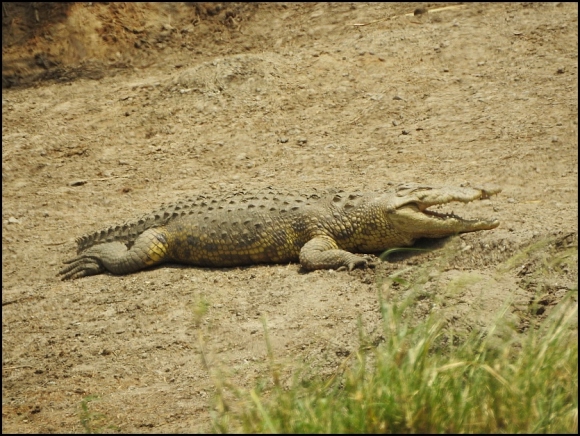
There were masses of birds here and 13 new species were added to the trip list – four Three-banded Plovers including a tiny chick, three Black Crakes, 40+ Common Waxbills, four Glossy Ibises, four Common Moorhens, a Ruff (pic), an AFRICAN SWAMPHEN, six Sand Martins, a White-browed Coucal, a Zitting Cisticola (Fan-tailed Warbler), a Little Stint, a Black-winged Stilt and a Striated Heron. We spent a long time here just enjoying the diversity a relatively small area of water brings in, I especially liked the British migrants that were here. There’s something quite special about seeing these birds, which may have been on my home patch not long before.

We moved on and immediately found a small group of six OLIVE BABOONS, another new mammal. I have also seen Chacma in South Africa and Guinea in West Africa.

New birds were added along the way including a smart Spur-winged Plover, FISCHER’S LOVEBIRD, two SILVERBIRDS and adult and juvenile BLACK-CHESTED SNAKE EAGLE. I really liked the Silverbirds, they were really smart flycatchers.
We drove on and were not far from our camp when we came upon a pride of Lions on a kill, that were being harassed by a Spotted Hyena. A few vultures sat in surrounding trees including two Hooded Vultures and two huge Lappet-faced Vultures (pic).


We left for Kati Kati Camp passing two more Secretary Birds on the way. The whole camp staff turned out to greet us. They settled us into camp chairs facing the plains and proceeded to give us a welcome drink and the obligatory safety talk. The most important point being we don’t leave our tent after dark on our own and must flash a torch to draw attention. We found out we were the only guests in camp that night. Retiring to our tent to freshen up before dinner we saw two Black-backed Jackals which were trip ticks. It was a very familiar tent similar to our previous safaris with a nice bed and a bathroom attached to the back. A rap on the back wall of the tent indicated that the hot water for our shower had arrived. A tank was filled with enough water for both of us, a simple chain system released the water, it was pretty effective. Duly clean, I stood outside the tent and flashed the torch for five minutes before someone arrived out of the darkness to escort us to dinner. We saw the need for this immediately as a Spotted Hyena was standing just a few yards from our tent door. We unloaded a rucksack full of batteries and gadgets and put them on charge as the only power points were in the main tent. Devis arrived and we had a very good three course meal, given it was prepared in the middle of nowhere, and I spent the most money I did all holiday US$25 on a bottle of white wine. Dinner dispatched we were led back to our tent, saying goodnight to the Hyena on the way. I heard the Lions roaring in the middle of the night, the Hyena cackled unnervingly a couple of times and something was on the roof for a bit. It was probably a mammal tick but there was no way I was going outside.
Sunday 8th September 2019
We awoke to find the camp surrounded by game. There were 32 Zebras, five TOPI, four Impalas, 20+ Thomson’s Gazelles and two Giraffes. The staff told us the Zebras move into the camp at night to be safe from Lions.

As we breakfasted three Spotted Hyenas trotted past the camp very close. We gathered our day rucksacks and set off for a full day in the Serengeti. Many birds were just outside the camp including the only Broad-billed Roller of the trip, a good bird here apparently.

We headed for a kopje (small rocky hill), which was supposed to be good for nailed on Leopard, but today nobody told the Leopard. However, it was good for birds with three lifers, three USAMBIRO BARBETS (a race of D’Arnaud’s), four GREY-CAPPED SOCIAL WEAVERS and four GREY-BACKED FISCALS and two new trip birds, a Northern Grey-headed Sparrow and a Tawny-backed Prinia, the lifers pictured below.
Crossing the next section of grassland were three White-bellied Bustards and another pair of Secretary Birds, perhaps the showiest yet. We joined a few cars watching a female Cheetah, but she was fairly distant and the views were never going to better those we had had already, so we moved on to where a Leopard was up a tree with prey but again the views weren’t great and we could only see its bottom half. However a RÜPPELL’S LONG-TAILED STARLING and a BROWN PARROT nearby were lifers.


A small pool nearby held our first Marsh Sandpiper of the trip, along with a Wood Sandpiper, a Black-winged Stilt and two Little Stints.

A second pool held 30+ Hippos and other common waterbirds as well as two Vervet Monkeys and nearby eight Elephants. We drove on to Seronera where we would have lunch.
Devis guaranteed we would see ROCK HYRAXES here and he wasn’t wrong, they were everywhere, on and under the picnic tables, lying on the lawns and sleeping in the flower beds. There were adults and good numbers of youngsters too. We were surrounded by birds too as we ate our picnic lunches. This included three lifers, AFRICAN GREY FLYCATCHER, female PURPLE GRENADIER (no pic) and RUFOUS SPARROW (Kenya Sparrow). Two fighting Grey-backed Cameropteras were new for the trip.
The afternoon started nicely with two big male Lions, sleeping mostly but one did pop up to pose for photos. A large pool held 150+ Hippos, a Nile Crocodile and a Green Sandpiper, new for the trip. Blacksmith Plovers and Egyptian Geese were present everywhere throughout the Serengeti and here was no different. Then we saw a Lioness, 35 Elephants and 150+ Cape Buffalo.



Throughout the afternoon we saw birds everywhere but the only lifers were WHITE-BELLIED CANARIES and WINDING CISTICOLA. We also saw a male Purple Grenadier. Then we found another pride of eight Lions, five females and three juveniles. Also over 150 Zebras, four Dwarf Mongoose, a Warthog, a pride of nine Lions, seemingly all females and a Black-backed Jackal.
At another pool we found another Nile Crocodile, four Reedbucks, 5+ Vervet Monkeys and the first African Hoopoe of the trip, which showed very well.
The radio crackled to life and Devis let us know a pack of African Hunting Dogs had been found, but they were a bit far away and there were no guarantees given the speed they move at, did we want to try. Oh yes! 20 minutes later we were watching the pack of c6 dogs, they weren’t moving fast, in fact they weren’t moving at all. They had just all flopped in a hollow under a tree on the plain and they were distant. Eventually we were rewarded when one of them found the energy to wander around for a few minutes before collapsing again. Not close views like we’d had in South Africa but always special. Also out on the plain was four Giraffes, four Warthogs, a Spotted Hyena and a pair of White-bellied Bustards walking amongst the dogs unconcernedly.
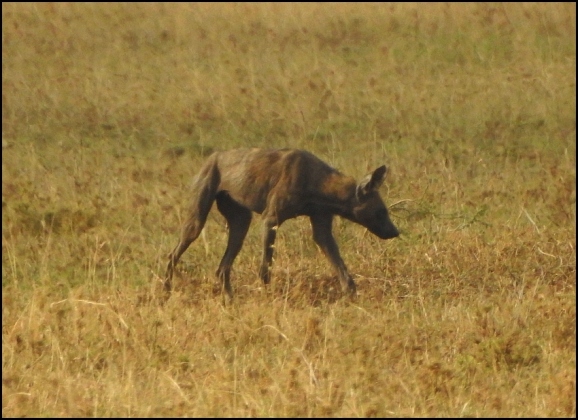
Then we started the long drive back to camp but on the way we had better views of the Leopard and spent too much time watching two male Cheetahs.


We arrived back at camp in fading light, hungry and well pleased with our day’s safari. The camp had been filled with French and German tourists so it was busier at dinner. We were asleep very soon afterwards, lolled off by the sounds of the amazing Serengeti.
Monday 9th September 2019
After breakfast and saying our goodbyes we left the camp but had barely gone 100 metres before we were stopping for two lifers, which we had already heard calling at breakfast. GREY-BREASTED SPURFOWL and two COQUI FRANCOLINS were showing well right by the track, an excellent start to the day.


We drove out past huge numbers of game, Zebras, Thomson’s Gazelles, Coke’s Hartebeests, Impala, Giraffe and a Spotted Hyena. Our first stop was to check the Leopard kopje again. A Rufous-naped Lark was a new trip bird. Just before we got to the kopje we found a pair of PYGMY FALCONS, the tiniest raptors I had ever seen. They looked like fluff balls in the cool morning air. Second best bird of the trip after Secretary Birds. Also here we had very close views of one of the ubiquitous Lilac-breasted Rollers, a bird made for photographers.


We drew another blank at the rocks but six Topi showed well and we found a RED-FRONTED BARBET and White-headed Vulture and Dark Chanting Goshawk were added to the list.
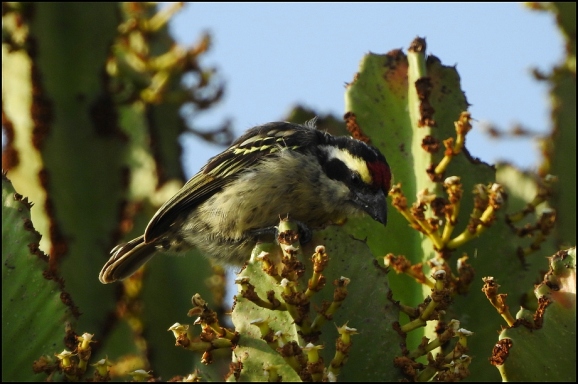

We stopped to watch two Cheetahs but they were fairly distant being lazy and it was hazy now with the sun warming everywhere quickly. Devis got a call to say the Leopard was up the tree again with prey and showing well so we drove there passing what Devis called a Tanzanian Christmas tree on the way, actually a bush full of Superb Starlings.


After enjoying watching the Leopard for a while we headed out to Lake Magadi, passing five Elephants and stopping to watch a herd of 20 Waterbuck of the Defassa race, a new subspecies for us, told by the absence of the white target on their rear. Common Waterbuck for comparison in the 2nd pic.


At Lake Magadi there were 32 LESSER FLAMINGOS, a welcome tick and there were some new trip birds, an Avocet, three Kittlitz’s Plovers (pic), four Sanderlings, a Dunlin and a Curlew Sandpiper. Two Black-winged Kites were hunting here.


As we drove back onto the plains there was a lot of animals including a big bull Elephant, three Giraffes, 20+ Olive Baboons, 200+ Cape Buffaloes and 20+ Thomson’s Gazelles. There were two new trip birds too, a pair of Long Crested Eagles (good name!) and a Brown Snake Eagle. Just before we arrived at Naabi Gate for lunch there was yet another Secretary Bird. It always seems to be the way with a bird you’ve constantly missed, once you’ve seen one you see them everywhere.


At Naabi Gate we had our picnic lunch and were again surrounded by birds, the best being a male BLACK-FACED WAXBILL, Black-browed Babblers again and a pair of showy Rock Martins, sat on the Gents window ledge.



After lunch between Naabi Gate and the park exit we saw 96 Grant’s Gazelles, a Topi and a Zebra and the only birds in a fast dusty sprint were a Greater Kestrel, two Ostriches and a Tawny Eagle. The only disappointment in leaving the Serengeti was we hadn’t yet seen a Black Rhino.
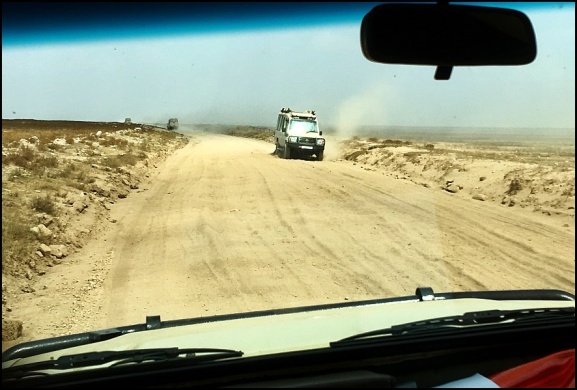
Then came the return bumpy ride up from the Serengeti to Ngorongoro Gate. Similar birds and mammals were seen, a Scrub Hare was new for the trip and we saw a BAGLAFECHT WEAVER on the rim. We checked out of the gate and drove to the town of Karatu where we would be staying at Bougainvillea Safari Lodge for two nights in considerable luxury after our bush tents.
After we’d checked in there was still enough daylight for a walk around the gardens. We managed nine species with Red-eyed Dove being a trip tick and a male Baglafecht Weaver showing nicely.
The evening meal was very nice and they kept coming around to give everyone seconds and thirds, it seemed a matter of pride that no-one left hungry. It was a lot noisier than we’d been used to with a party of around 30 Americans, mainly girls, there for the night on their way to Serengeti. It seemed strange to sleep in a solid room with only town noises in the background.


Tuesday 10th September 2019
Today was a day we’d been looking forward to for a very long time, we were going into the Ngorongoro Crater, another bucket list place. It was also our last chance to get Black Rhino. Unfortunately overnight I’d developed Tanzanian Tummy, but thanks to a good supply of Imodium and really good rest stops I managed the day, because there was no way I wasn’t going.
I was out before breakfast as usual and had three new trip birds in the gardens, five White-browed Robin Chats, a Tropical Boubou and a male Variable Sunbird.



We drove up again to the Ngorongoro Gate, Devis got the permits and we stopped at the viewpoint for photos before the descent into the Crater.

We drove uphill from the viewpoint at first, stopping for what I thought was a Common Blackbird, I was completely confused by it. Devis sorted it out though, it was the oldeani race of Olive Thrush, now split by IOC as ABYSSINIAN THRUSH. Also here were three WHITE-EYED SLATY FLYCATCHERS and a pair of Purple Grenadiers.


Then we stopped at the top gate to use the restrooms, which also happened to be a great spot for sunbirds. We had three species, one of each, two of which were ticks, a GOLDEN-WINGED SUNBIRD, a BRONZE SUNBIRD and a Variable Sunbird. Paperwork checked we started the descent into the Crater. The Ngorongoro Crater, is the world’s largest inactive, intact and unfilled volcanic caldera. The crater formed when a large volcano exploded and collapsed on itself 2-3 million years ago. It is 610 mtrs (2000ft) deep and its floor covers 260 sq kms (100 sq mls).



On the way down a few Cape Buffalo were by the track and one of them had a Yellow-billed Oxpecker as a companion, we had previously only seen Red-billed. In a bush opposite a Black-crowned Tchagra was also a trip tick.

Beside the descent track were Capped Wheatears and African Pipits and a party of 35+ Olive Baboons. We started to see Zebra’s, we saw over 700 during the day and that was a conservative count. A cisticola caused a few problems but was identified as a PECTORAL-PATCH CISTICOLA. We passed a Lappet-faced Vulture on a nest and then had good views of two Black-backed Jackals.


We started to see many Wildebeests, the first of over 1100, all the Wildebeests in the Crater were the darker WESTERN WHITE-BEARDED WILDEBEESTS, a new subspecies for us.

We arrived at a waterhole, which was alive with birds and surrounded by game. Birds included a HOTTENTOT TEAL, and five new trip ticks, an African Fish Eagle, a Grey Heron, an African Spoonbill, two Red-knobbed Coots and six Red-billed Teal. Also there was two pairs of Blacksmith Plovers, 20+ Black-headed Herons, 10+ Sacred Ibises, 13 Cattle Egrets, three GREAT WHITE PELICANS, 70+ Egyptian Geese, four Yellow-billed Storks, two Common Moorhens, a Black Crake, an African Swamphen and a Hamerkop.
In the waterhole were 60+ Hippopotamus and around the edges a pack of 11 Spotted Hyenas were mischievously causing the game to stampede without any real thought of catching anything.




Suddenly the radios in all the Landcruisers crackled to life, a BLACK RHINOCEROS had been found, and it was only half a mile away. We joined the exodus and sped towards it. There it was, our first BLACK RHINO, it was fairly distant but views were much better than any photos due to the heat haze and the dust the game was stirring up. I didn’t care, this was a big tick! We watched for a long while hoping it would move closer. Rangers in a Landcruiser drove out to it to check it out as they keep tabs on all the Black Rhinos in the crater. There are now more than 50 of this extremely endangered mammal there. It looked for a while like it might charge the cruiser but in the end moved away. So we did too, heading to the lake at Ngoitokitok Picnic Area for lunch, passing a flock of 14 Grey Crowned Cranes on the way.

Here it was reasonably safe to get out and stretch our legs. In the lake there were 20+ Hippos, mostly distant, but a couple were close and one had a Common Sandpiper on its back. It looked very incongruous, and I thought this could’ve been on my patch back home not long ago. We ate inside the vehicle because if you were outside you ran the risk of Yellow-billed Kites or Pied Crows snatching your food. Even then Rufous-tailed Weavers were coming inside to grab any crumbs. An adult and a juvenile African Fish Eagle were also here and a Little Grebe was a trip tick.

After lunch we set out again and immediately came upon a new mammal, an AFRICAN GOLDEN WOLF, the first of three. Two Collared Pratincoles were new also, a flock of six Yellow-throated Sandgrouse were very close (female pictured) and a Kori Bustard sat next to the vehicle completely unfazed.

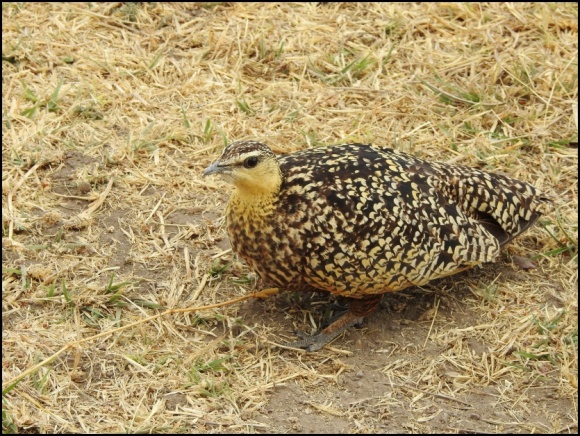

Our last stop was a waterhole near to the exit road. It was packed with all the usual waterbirds but I was especially pleased to find a male Greater Painted-snipe, only my second ever. It was a first for the Crater for Devis, so he was pleased too.

Finally we added four House Martins to the list and began the ascent out of the Crater. On the rim a Blue Monkey dashed across the road but we only really saw its hind legs and tail as it disappeared into the bush, but Devis assured us we would see them at Lake Manyara tomorrow.
As we checked out at Ngorongoro Gate we watched a group of Olive Baboons using some poor drivers car as an adventure playground.
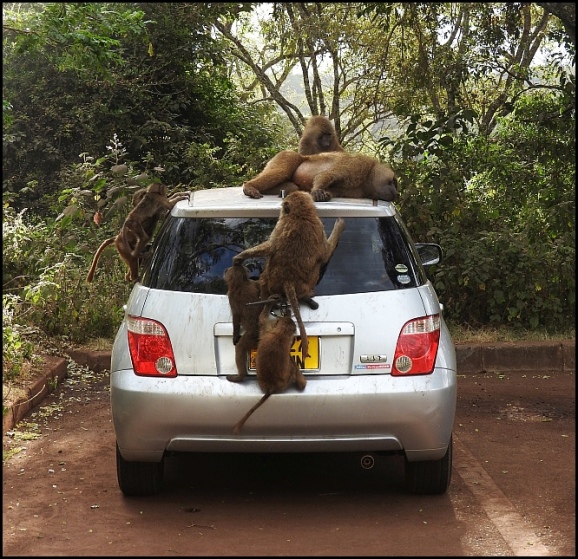
Wednesday 11th September 2019
The last day had arrived and we checked out before dawn following a very early breakfast. However it was going to be a good day as we were off to Lake Manyara. It was only an hour’s journey so we arrived with the sunrise. A quick rest stop at the entrance was made more nervous by the amount of Olive Baboons about, they were everywhere, and I don’t trust them.
Along the entrance road, as promised we had good views of five BLUE MONKEYS. Also here we had three species of Hornbill, Crowned, which was new, African Grey and Silvery-cheeked and also new a Palm-nut Vulture.

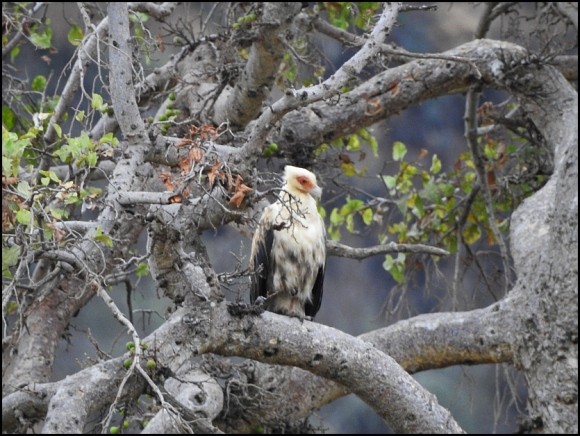
We entered an area of thicker bush, Hadeda Ibises were in a stream (pic), and the list was added to with a lovely Grey-headed Bushshrike, a Pearl-spotted Owlet spotted in deep cover by Bridgette (pic) and an immature Gabar Goshawk. We also had nice views of tiny Emerald-spotted Wood Doves (pic) and a female AMETHYST SUNBIRD was a lifer.



The next group of bushes were full of birds with Little Bee-eaters, Black-crowned Tchagras, Fork-tailed Drongos, Speckled Mousebirds, Red-bellied Firefinches all searching for food. Black-necked Weavers were new and two BUFF-BELLIED WARBLERS were lifers. Also the only Smith’s Bush Squirrel was seen here.
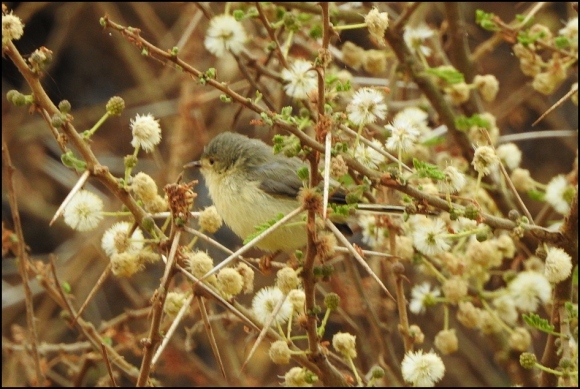
We came out of the bushes and the lake was before us and there were thousands of bird. A distant pink band of 2000+ Lesser Flamingos, a swathe of assorted terns included Whiskered, White-winged Black and Gull-billed and then masses of assorted waders. I realised for the first time that I should’ve brought a scope because I’m sure I missed a few species here, because the water levels were low and hence the birds were distant. You were not allowed to leave the tracks here to get nearer unfortunately.


We drove to a part of the lake where we could get nearer to the birds, passing Zebras, Impalas, Wildebeests, Buffalos and two Giraffes. I could only estimate numbers of birds here and probably undercounted. The water birds included 500+ Great White Pelicans, 300+ Yellow-billed Storks, four Saddle-billed Storks, a Marabou Stork, three African Spoonbills, six Hamerkops, five Squacco Herons, a Black Heron, an Intermediate Egret, three Little Egrets, 70+ Glossy Ibises, 20+ Sacred Ibises, two Spur-winged Geese, 10+ Egyptian Geese, two very close Hottentot Teals, 10+ Red-billed Teal, 20+ African Jacanas, seven Black Crakes, nine Common Moorhens and an African Swamphen. Little Egrets, Saddle-billed Storks and Black Heron were trip ticks. The tern flock here contained at least two summer-plumaged adult White-winged Black Terns. Waders here included seven LONG-TOED LAPWINGS, Black-winged Stilts, Avocets, Crowned Lapwings, Wood Sandpiper, Sanderlings, Spur-winged Plovers and a Common Sandpiper. Two Hippos sat in the middle of them all and an adult African Fish Eagle watched over the proceedings. A flock of 15+ Wattled Starlings were new and 20+ White-backed Vultures squabbled over the last remains of a Wildebeest.
And that was that, or almost, there was the small matter of a 115 mile 3+ hour drive back to Kilimanjaro Airport. We didn’t see much on the way, mainly Pied Crows and Black-headed Herons but a WHITE-BELLIED GO-AWAY BIRD flew across the road at Meserang to become the final lifer of the trip. Traffic was bad through Arusha and we made a brief stop at a hotel to be debriefed by Adam to make sure we were happy with everything and that Devis had been a good guide. We assured him everything had been great and that Devis had been a brilliant guide and companion.

We arrived at the airport in good time despite the traffic and said our goodbyes to Devis. Tanzania had been wonderful and we would thoroughly recommend it, we had only seen a tiny part of what is available. If you have any questions feel free to ask.

Tanzania had one final gift as we lifted off for home, the clouds had parted and we got to see Mount Kilimanjaro in all its glory, a fitting end.

Mike & Bridgette King The Gloster Birder © 2019





 County news, sites to visit, trip reports and other information about birds in Gloucestershire and beyond, since 2000.
County news, sites to visit, trip reports and other information about birds in Gloucestershire and beyond, since 2000.